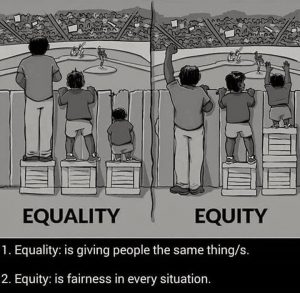One of the best metaphors for understanding what a Universal Design for Learning experience might feel like would be by studying how we use GPS (Global Positioning System) technology. Our GPS units provide us with timely interventions to support us in getting where we wish to go in an efficient manner. They give us choices in our routes: are we traveling by public transit, by car, or walking? Would we like to get there as quickly as possible or do we prefer to take side streets? Or would we enjoy a commute with a nice view? We can alter the voice, language, screen layout, view, and even download untold additional features to customize our experience with our GPS unit. The GPS is such a popular support that we take it everywhere we go, just in case we need it.

CC Image shared by Leigh Black, retrieved from https://www.flickr.com/photos/leighblackall/26701766821/
You may be familiar with this graphic showing three young people attempting to watch a ball game. The model promotes the idea that “Fair isn’t always equal” because the three individuals do not need the same thing. Fair would be all three children receiving the same box, but how would that help the shortest child? The “fairness” model suggests certain scaffolds or supports might be required by the two children who cannot view the game.
UDL takes a different approach: what if we removed the barrier? If the obstacle (in this case the solid wooden fence) were removed, all three could enjoy the view without requiring additional supports. Identifying the barriers in the design instead of labelling the struggles of the learner is the foundation of planning with UDL in mind.
Universal design is a pedagogical approach grounded in neuroscience. The core principle of Universal Design for Learning (UDL) is that designers focus on the limitations of their designs rather than any perceived limitations of their learners. This goes beyond mere accessibility as it requires the designer to build in both support and challenge for all learners. This requires a shift in thinking, as we often speak in terms of helping learners to overcome barriers. Maximizing learning for all learners requires minimizing or eliminating any possible barriers in your design.
Framework
Identifying possible barriers that may interfere with a learner meeting the outcomes means providing flexible pathways in the design. The principles of Universal Design identify these three pillars as part of their guidelines framework:
- Multiple means of representation
- Multiple means of action or expression
- Multiple means of engagement
This framework is meant to be translational and is not a substitution of one new rigid set of rules for old ones. It should be perceived as a set of guiding principles. Learning designers can provide curriculum with affordances and flexibility to amplify the natural strengths of their learners while reducing barriers. Success can only occur when both the learner and the curriculum interact in such a way that they both improve at the same time.
Planning for multiple means of representation means providing more choice in how a learner accesses materials and information. This would require providing materials with visual, auditory, and and kinesthetic options, as well as supporting prior knowledge and providing timely supports with necessary skills. Planning for multiple means of action or expression could look like learners demonstrating their new knowledge or skills in different ways. As mentioned in previous posts, formative assessment informs both the instructor and learner about how effective the learning design is for that learner, allowing the instructor to make adjustments. The context is important, meaning an instructor should teach in the manner in which they plan to assess. Providing multiple means of engagement means planning for a variety of pathways into the learning experience and supporting learner self-efficacy. UDL maintains the importance of holding high expectations and standards for all learners. The guidelines should prompt designers to evaluate their planning for any barriers for learners, while still maintaining appropriate challenge for all participants.
How it benefits all learners
Universal Design is well understood in engineering terms. There is an understanding that when a design includes improvements for some members of the population, there can be a benefit for other users as well. A common example is curb cuts. When a curb is sloped for accessibility for wheelchair users, it can also benefit people with strollers, cyclists, scooters, and people using rollerblades. This feature may have been designed to meet a specific need, but benefits many other users. Design to accommodate the widest spectrum of users without the need for additional adaptations. Meyer et al (2014, pg. 51) state that the core tenet of Universal Design for Learning is:
What is essential for some is almost always good for all.
Technology has granted learning designers so many different options and timely supports for both learners and instructors. Digital media is far more malleable than print options. When a new student who was experiencing significant hearing loss joined our class years ago, our room was retrofitted with microphones and speakers. Instructors were coached on speaking clearly and enunciating. There were still obvious barriers for that learner in hearing their peers and engaging in classroom discussions. We used one of the affordances of Google docs: the speech-to-text feature. With permission, we kept it recording the classroom lessons and discussions. As learners and instructors spoke, it captured voices and recorded as text. The student with hearing loss kept a Chromebook open on their desk so that they could read along and be included. This live document worked well when another student joined the class weeks later who was just starting to learn English as a second language. This learner could have the same document open on their screen but set to translate directly to Arabic. Language and hearing loss were the identified barriers being addressed. An unexpected benefit was how many students accessed the “transcripts” of a class to catch up on things they missed because of the pace of the lesson, or distractions in the room, or because of absences. Removing barriers for some learners may have unexpected positive consequences for other learners as well. If your lesson is designed in a constructivist way, it is important to ensure that all learners are included in creating knowledge.
Addressing barriers in our design before they impede the progress of learners is the ultimate goal of a designer planning within a Universal Design for Learning framework. Switching our lens from focusing on addressing accommodations for individual learners to understanding how those supports might best benefit the entire group of learners may lead designers to creating greater accessibility in their designs.
References:
Meyer, Anne, et al. Universal Design for Learning: Theory and Practice. CAST Professional Publishing, an Imprint of CAST, Inc., 2014, UDL Theory Practice, retrieved from: udltheorypractice.cast.org/



Leave a Reply